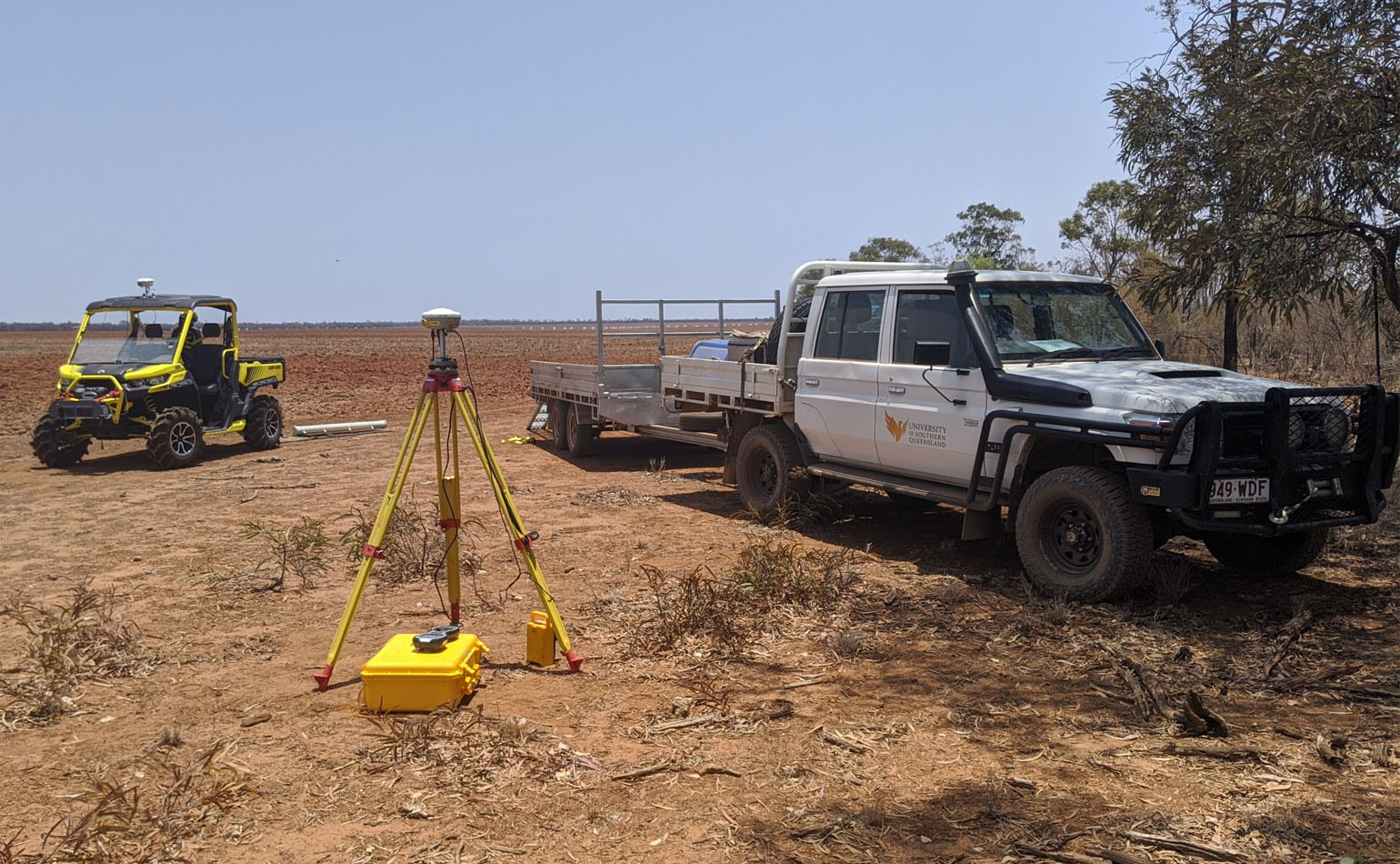A proximal sensing platform in the field
The University of Southern Queensland (USQ) was established in 1990, having begun life in 1967 as an institute of technology.
USQ has strong research capability, ranking well above the world standard in over 15 fields of research including agriculture, land and farm management, environmental science and management, crop and pasture production, microbiology and chemical and physical sciences.
Most of the team from USQ who work with the Soil CRC are based in the Centre for Sustainable Agricultural Systems.
The Centre for Sustainable Agricultural Systems (CSAS) was established in 2018, but the research groups that formed it have operated at the university since 2010. They conduct research and engagement to enhance the management of agricultural enterprises as complex and embedded systems, maximising production and conservation outcomes. This is achieved through a trans-disciplinary approach focusing on precision management of the biophysical resources that simultaneously considers the social, environmental and political contexts.
Some of the key research themes include spatial diagnosis and management of system constraints; maximising ecosystem services in agricultural and silvicultural systems; managing human-wildlife interactions; soil-plant-water integrated system dynamics; soil security; analysis and modelling of agricultural systems and catchments; agronomy and crop physiology; and agrimetrics for planning, policy and land management.
The team from USQ bring expertise to the Soil CRC in the following areas:
- Carbon assessment, mapping and auditing (spectroscopy)
- Policy development, risk mitigation and practice adoption
- Soil structural evolution and dynamic change
- Management and amelioration of integrated soil constraints including economics
- Return on investment mapping
- Spatial modelling and digital soil mapping
- Proximal sensing (spectroscopy, electromagnetic induction, machine vision)
- Instrumentation, mechatronics and electrical engineering (including electrochemical instrumentation)
- Biophysical and probabilistic modelling at point and spatial scales
- Software and model creation and development with strong industry input
Why the Soil CRC?
At the very core of CSAS is the importance of soils, both nationally and globally. Soils affect nearly everything we do and affect our day to day lives in ways many of us don’t consider, such as our very own health. The Soil CRC brings this importance to the Australian conversation and is a vehicle to establish strong collaborative networks. The research needed transcends any single discipline and any single research group, so being a part of this larger initiative is important for USQ.
Almost all agricultural industries are represented within a 500 km radius from USQ. For many years USQ has worked within these diverse systems and their stakeholders. There are researchers working side by side, day by day in policy, economics, crop science, soil science, engineering, ecology, modelling, social science, machine learning, and pedometrics. Additionally, there are globally leading research centres at USQ in agricultural engineering, as well as materials and fibre composites. USQ has a good track record for providing solutions that are not just technically and scientifically sound, but well adopted and received by next users.
Soil CRC projects USQ are working on:
New sensors for measuring soil nutrients – led by Dr Craig Lobsey University of Southern Queensland with collaborations with Burdekin Productivity Services, Herbert Cane Productivity Services and Manaaki Whenua Landcare Research New Zealand.
Improving decision support systems – led by Dr Keith Pembleton, University of Southern Queensland with collaborations from University of Tasmania, NSW Department of Primary Industries, Burdekin Productivity Services, Birchip Cropping Group, West Midlands Group and Riverine Plains Inc.
Why soil management practices are adopted – led by Professor Vaughan Higgins, The University of Tasmania, with collaborations from Birchip Cropping Group, Central West Farming Systems, Charles Sturt University, Eyre Peninsula Agricultural Research Foundation, Mackillop Farm Management Group, Riverine Plains Inc., University of Southern Queensland and Western Australian No-Tillage Farmers Association.
Collaborative approaches to innovation – led by Dr Nicholas Pawsey, Charles Sturt University, with collaborations from Federation University, Murdoch University, University of Southern Queensland and University of Tasmania.
‘Smart’ soil sensors – led by Dr Marcus Hardie, University of Tasmania with collaborations from University of Southern Queensland.
Visualising Australasia’s Soils – led by Associate Professor Pete Dahlhaus, Federation University with collaborations from Landcare Research New Zealand, University of Tasmania, University of Southern Queensland, Birchip Cropping Group, Burdekin Productivity Services, Central West Farming Systems, Gillamii Centre, Herbert Cane Productivity Services, Landmark, Liebe Group, Mackillop Farm Management Group, Mallee Sustainable Farming, North Central Catchment Management Authority, Riverine Plains Inc, Southern Farming Systems, WANTFA and Wimmera Catchment Authority.
New products for subsoil constraints – led by Dr Ehsan Tavakkoli, NSW Department of Primary Industries with collaborations from University of Southern Queensland and the University of Newcastle.
Regenerative farming systems – led by Dr Gwen Grelet, Manaaki Whenua Landcare Research New Zealand with collaborations from University of Southern Queensland, Charles Sturt University, Agriculture Victoria, NSW Department of Primary Industries, PIRSA, Southern Cross University, Southern Farming Systems, Soils for Life and University of Newcastle.
USQ Researchers that are working on Soil CRC projects:
| Researcher | Field of expertise |
| Geoff Cockfield | Agricultural natural resources management policy Environmental politics |
| John McLean Bennett | Soil structural dynamics Soil-water and solute movement Spatial modelling (Pedometrics) Soil security (including soil health) Agricultural extension and education |
| Keith Pembleton | Agricultural systems modeling Crop and pasture agronomy and physiology |
| Ravinesh Deo | Artificial Intelligence and Image Processing Pattern Recognition and Data Mining Numerical and Computational Mathematics |
| Craig Lobsey | Proximal sensing Spectroscopy Precision agriculture Spatial modelling (Pedometrics) Instrumentation and electronic engineering |
| Yingcan Zhu | Soil structural dynamics Materials engineering Analytic and physical chemistry |
| Stirling Robertson | Spatial modelling (Pedometrics) Digital soil mapping and assessment Soil constraint management Agricultural engineering |
| Chloe Lai | Soil constraints Pedometrics Biophysical modelling |
| Roy Anderson | Software development Model development |
| David West | Soil constraints management Proximal sensing Instrumentation and automation |

